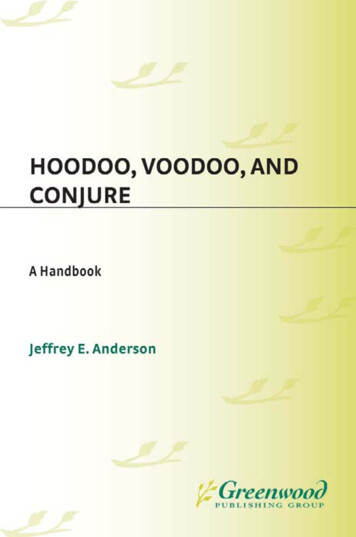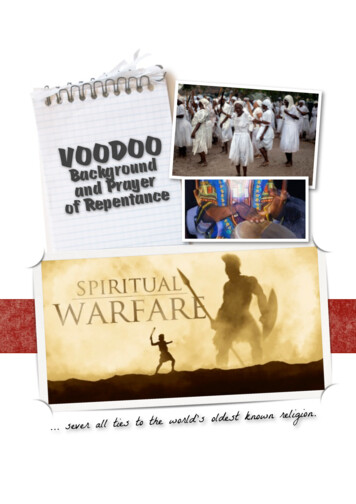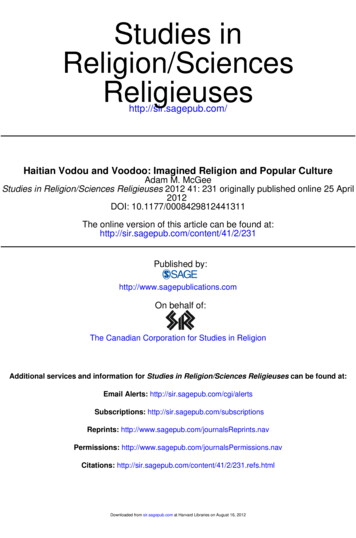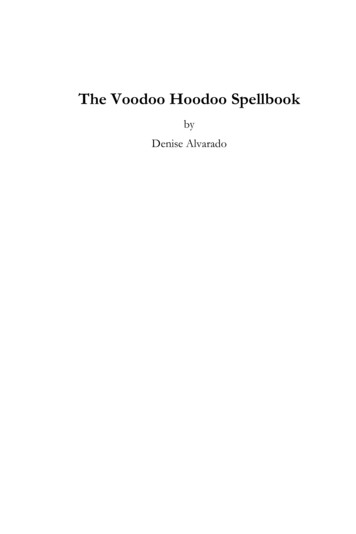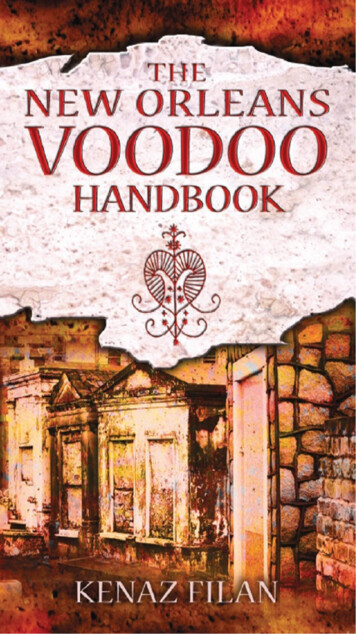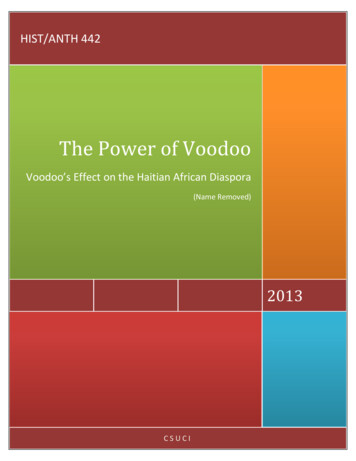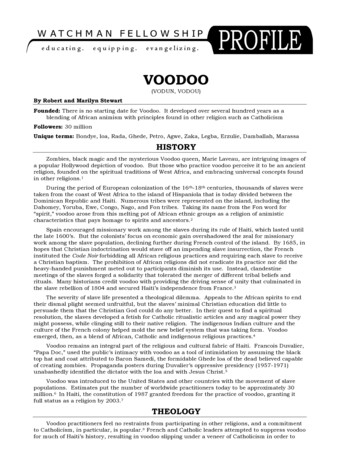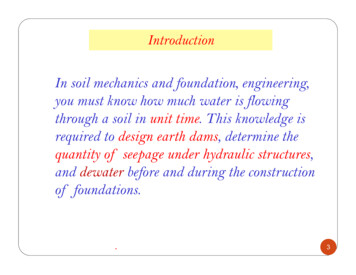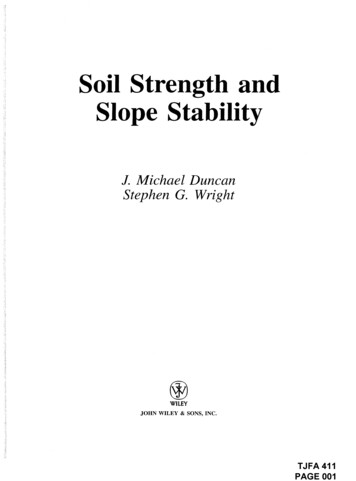
Transcription
THEMEDICALVOODOOByANNIE RILEY HALEAuthor of "These Cults," "The Natural Wayto Health," etc.Gotham HouseNew York1935
The Medical Voodoo, Copyright, 1935,by Annie Riley Hale. Manufactured inthe United States of America.
To my son, Shelton Hale
"Theoretical immunology, now considered thenewest branch of scientific medicine, is in reality theoldest clinical science. The medicine men of the Congo,and the jungle doctors of the Orinoco, have today animmunological theory that is more detailed and of widerclinical application, than the boasted immuno-science ofNordic medicine."There is not a fundamental deduction from presentday infections theory, that was not known, predicted orparodied, by the pre-dynastic Osiers of Ancient Egypt—50 centuries before the 19th Century renaissance of thesame deductions."Dr. W. H. Manwaring, Professor ofBacteriology and Experimental Pathology atLeland-Stanford University, Palo Alto, California.
FOREWORDThis book issues a flat challenge to so-called "scientificimmunology," and is an arraignment of the crimes committedin its name. The arraignment is based on statistical facts ofrecord, derived mainly from medical sources, and on wellauthenticated medical opinion. Only the bigots and fanatics of"regular" medicine will seek to discredit the ground-work ofthis indictment because it is prepared by a lay researchworker. Facts are facts—regardless of who brings them.If to some readers the conclusions reached appear tooharsh in some instances, I can only say: It is not I, but thefacts which render judgment. Too many lives have alreadybeen sacrificed to a squeamish regard for the family doctor,who—if the truth were known—is in many cases also thevictim of the same system of medico-political rule underwhich the "scientific immunology" is taking its frightful toll.If the book shall serve no other end than bringing topublic attention the much neglected though eminent medicalvoices—past and present—raised in dissent and protestagainst the vaccine-serum method of "disease prevention," itwill have supplied a long-felt need. Very many persons do noteven know that such dissenting voices exist; and if the mattermust be settled for us solely upon medical authority, thensurely it is only fair to the public having a vital interest in thesettlement, to permit them to hear from all the authorities."He who knows only his own side of a question, doesn't knowthat very well."The book aims to present "the other side" of the medicalcontroversy over so-called "preventive medicine" for those whonever heard that there is another side.A. R. H.
CONTENTSCHAPTERI.PAGEWhere Seer and Healer Met13The New Necromancy24III.Natural vs. Artificial Immunology41IV.Just What Is the Smallpox-Vaccine?53Some Early and Later Fruits; Statistics vs.Statistics70Who's Who Among Anti-Vaccinists94II.V.VI.VII.Enter Pasteur with the Microbe123The Death Trail of the Microbe Hunters154The Voodoo and the Cancer Riddle193The Voodoo and Vivisection—Animal andHuman212.A White House Interpretation of Child Welfare233Medical Jurisprudence Plus Medical Ethics253XIII.Medical Voodoo and the Public Health270XIV.Medical Voodoo and the Business World292Medicine, Religion and Government302VIII.IX.X.XI.XII.XV.
CHAPTER IWhere Seer and Healer MetWhen we consider the mysterious nature of the LifePrinciple—as great a mystery to the most learned physicianas to the most illiterate layman—the hidden physiologicalprocesses, and the more or less psychic elements in all diseaseproblems, it is not surprising that the earliest religious faithsof the world were inseparably linked with primitive notionsabout the origin and control of disease; and that the offices ofpriest and shaman (medicine man) met in the same person.The seer, the ecclesiastic, and the healer, functioned as one.And although in succeeding ages these offices becamedistinct and separate professions—pursued by differentgroups, trained in different schools—the essential root-idea inthe two callings persisted, and down' to the present day thedoctors of the body and the doctors of the soul have much incommon.Their popularity rests on the most omnipresent humaninfirmity—fear. In all ages fear of pain and sickness hasdriven the human race into the arms of the doctor; fear ofdeath and hell into the arms of the priest or parson. And inall ages learned clerics, mitred prelates, eminent physiciansand surgeons—equally with the soothsayers and witchdoctors of primitive peoples—have not scrupled to make freeuse of the fear-appeal in the prosecution of their business.Fear, ignorance, superstition and credulity have everbeen the hand maidens of the sacerdotal and healing cults,modified in all times by the degree of civilized advancementand cultural development of their votaries.Pre-historic man interpreted such natural phenomena ascyclones, cloudbursts, earthquakes and drought as theoutward and visible signs of angry gods. The conception ofpower unaccompanied by the desire to use it malevolently,appears to have been beyond the primitive mind. Hencedisease was likewise believed to be the work of demons andevil genii, or of an offended shade of the dead, or in certaincases it was traced to the malicious spell of a human enemypossessed of extraordinary powers—witchcraft and sorcery.The remedy was, in the one case, propitiation of theoffended divinity or shade—with burnt-offerings and sacrifice;or the punishment of the human disease-conjurer, withflagellation and death. Hence the barbarous practices ofwitch-burning and flogging of the insane—accused in savagesuperstition of "demoniacal possession.""The common point of convergence of all medical folklore," says Dr. Fielding Garrison in his History of Medicine,"is the notion that spirits or other supernatural agencies arethe efficient causes of disease and death. . . . Ancient andprimitive medicine, whether Assyro-Babylonian orScandinavian, Slavic or Celtic, Roman or Polynesian, hasbeen the same—in each case an affair of charms and spells,
plant-life and psychotherapy, to stave off supernaturalagencies."According to another medical historian, AlexanderWilder, these medical superstitions are coeval with theearliest traditions on all other subjects. "Every countryhaving a literature of ancient periods of its history," saysWilder, "possesses some account of a healing art, whosehistory is therefore as old as the history of the race; andproperly speaking, we have no 'Father of Medicine' except ineponym."The elder Pliny ascribed the origin of medicine as an artand pursuit to the Egyptians. Others traced it to Arabia, andothers still to Chaldea. Inasmuch as the relative antiquity ofthe different countries is a disputed point, giving preferenceto any one of them in priority of the healing art is notimportant. But the superior knowledge and skill of the priestphysicians of Egypt, the pastiphori, as they were called,entitles them to special mention.According to Garrison, their knowledge of chemistry wentfar ahead of any of their contemporaries. Indeed the wordchemistry is derived from Chemi—the "Black Land"—theancient name of Egypt, and chemistry in the early time wasknown as "the black art."Garrison also accredits the Egyptian priest-physicianswith unusual skill in metallurgy, dyeing, distillation,preparation of leather, making of glass, soap, alloys andamalgams; and says "in Homer's time they probably knewmore about anatomy and therapeutics than the Hellenes."The Egyptian reverence for a dead human body forbadeits dissection as sacrilege; but it was from their extraordinarycustom of mummification—an outcome of their religiousregard for the body—that they acquired their knowledge ofanatomy; and in perfecting their art of embalming the dead,the pastiphori also gained their knowledge of chemistry andbecame pioneers in that branch of medicine.But with all their knowledge and skill in the secular arts,the ancient Egyptians were intensely religious. Thepastiphori mingled prayers and invocations of the nationalgods with the compounding of their prescriptions, and thepatients to whom they were administered were instructed tolook to the appropriate divinity for the cure. Isis, "the GreatMother and Madonna," was also Goddess of the Secret Shrineand patroness of the healing art. Their god Thoth—called bythe Greeks variously the "Egyptian Hermes" and the"Egyptian Apollo"—was the god of astrology and alchemy,and the tutelary deity of all sacred and sacerdotal learning.Six of the Books inscribed to him were devoted to medicineand surgery, and the various treatises were set forth asspecial revelations from Thoth.Our knowledge of the status of medicine in ancient Egyptis partly derived from the works of Homer and Herodotus,partly from hieroglyphics on temple walls and monuments,but chiefly from the famous papyri, of which the best known
and most complete are the Ebers translations dating from theearliest reigns.From all these it appears that medical practice among theancient Egyptians took on some of the features of modernprocedure. According to Herodotus, they had specialists notunlike our moderns. He says: "Each physician treats a singledisorder and no more. Thus the whole country swarms withmedical practitioners, some undertaking to cure diseases ofthe eye, others of the head, others of the teeth, others againthe intestines, while still others treated complaints which arenot local—their maxims being even if but a small part of thebody suffers, the whole body is ill."In this respect ancient Egyptian insight into thefundamentals of disease appears superior to that of somemedical men of our own time. For it is not uncommon to hearpersons remark: "My doctor tells me I am perfectly soundexcept I have a bad heart, or weak bronchia"—or impairmentof some other vital organ. Indeed we have seen it stated inperfectly orthodox and authentic medical literature, that "onereason it is so difficult to detect the early stages of cancer isthat it frequently develops in otherwise healthy persons"!Wilder's History of Ancient Medicine relates that theEgyptian temples were schools of learning wherein the priestphysicians (the pastiphori) "were carefully instructed in thevarious branches of knowledge by professors excelling inerudition. And when they attained their senior degree theywere admitted to the dignity of Scribes of the Temple, andentitled to maintenance from the Royal Treasury."Thus every temple had its staff of medical practitioners,and whoever required the services of a physician sent thitherfor him with a statement of the ailment from which thepatient was thought to be suffering, when the chief of themedical staff would select the one he deemed best suited forthe case. Wilder says further:"Deriving their support from the lands of the priests andpayments from the Royal Treasury, the pastiphori received nofee or honorarium from patients. Whatever payment wasmade in acknowledgement of their services belonged to thetemple with which they were connected. They were obliged toattend the poor and to go on foreign journeys and militaryservice without remuneration."The earliest and most famous of these temple-universitiesin the ancient Kingdom by the Nile were those located at Onand Memphis, and were built by Menes, the traditionalfounder of the first Egyptian Dynasty. After the expulsion ofthe "Shepherd Kings"—Hyksos—and the establishment of the19th Dynasty under Seti the Conqueror, he resolved to buildat Thebes an Akademeia which should rival the priestlyseminaries of Lower Egypt.Vast sums were expended on it, and the "House of Seti"became the largest of all the sanctuaries except the one builtby the great Thothmes. In it were celebrated the services forthe royal dead and the arcane rites of the gods. Here priests,
astronomers, physicians and students of every branch ofknowledge, were taught all the sacred and secular lorepeculiar to that mysterious "Black Land."There was an extensive library connected with theAkademeia to which the students had free access, and a paperfactory for making the papyrus. According to Garrison, thefamous Ebers Papyrus starts off with a number ofincantations against disease. It then lists a number ofmaladies—describing them in detail—with their appropriateremedies to the number of 700. Garrison does not concede tothe Egyptians any "special scientific advancement in thehealing art" because of this extensive pharmacopoeia,however. He thinks "a few well-selected drugs, such as opium,hellebore, etc., employed by the later Greek physicians withskill and discrimination" show much greater therapeuticinsight.Garrison's preference for the Greek over the Egyptianskill in ancient medicine is further shown in the statementthat "from the time of Hippocrates (460-370 B.C), Greekmedicine advanced while the Egyptian remained stationary,and long before the Alexandrian period Egyptian civilizationwas at a stand-still, while in medicine Egypt was going toschool to Greece."The reason assigned for this by Garrison was that "laterEgyptian medicine was entirely in the hands of the priests;while Greek medicine even at the time of the Trojan Warwould seem to be entirely free from priestly domination—surgery in particular being often practiced by Homer'swarrior-kings."It may be remarked incidentally that surgery at the timeof the Trojan War—and for many centuries thereafter—wasnot as closely bound up with materia medica as it is atpresent. But since another medical narrator, Dr. CharlesLoomis Dana of Cornell Medical College and ex-president ofthe N. Y. Academy of Medicine, also claims in Peaks ofMedical History (1927) that "Hippocrates separated medicinefrom jugglery and witchcraft; and the Alexandrian andHippocratic periods marked the gradual separation of thehealing art from priestcraft"; it may be interesting andinstructive to inquire somewhat closely into the historicgrounds for such claims.This is the more incumbent in that two very recentresearch workers in this field, Richard Hoffman,
Medical Voodoo and the Public Health 270 XIV. Medical Voodoo and the Business World 292 XV. Medicine, Religion and Government 302 . CHAPTER I Where Seer and Healer
